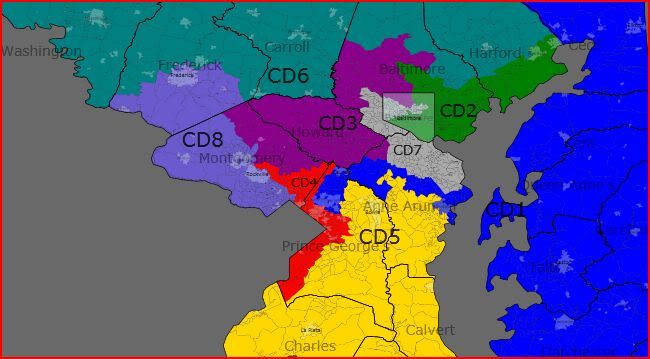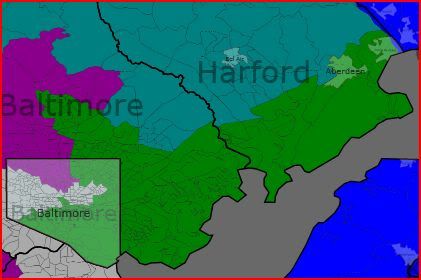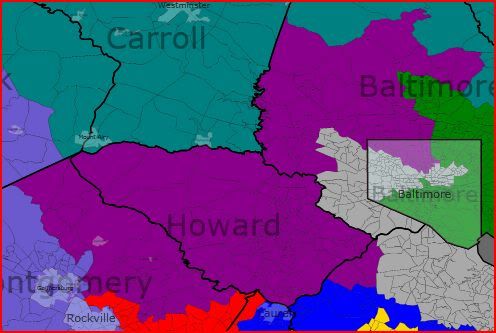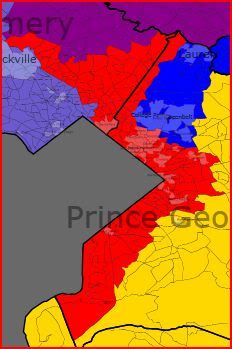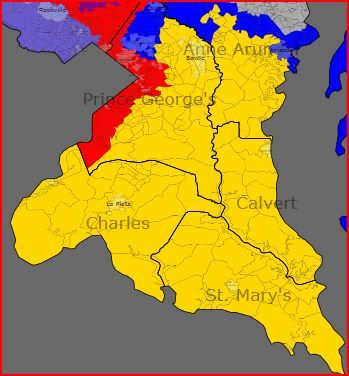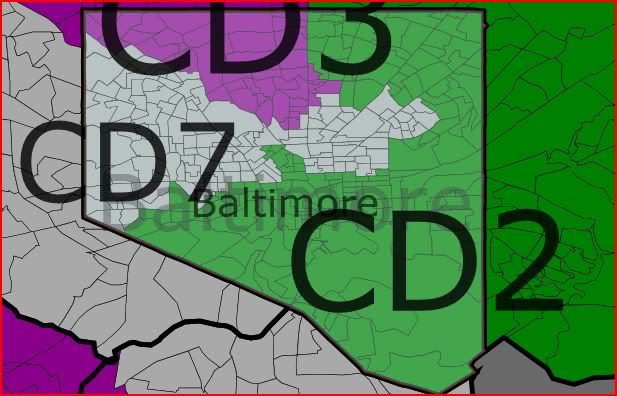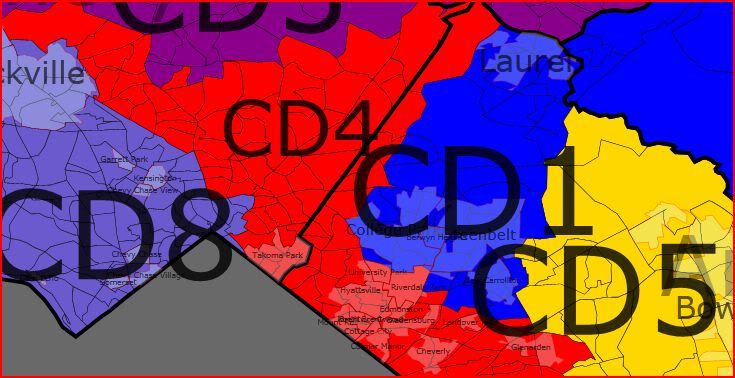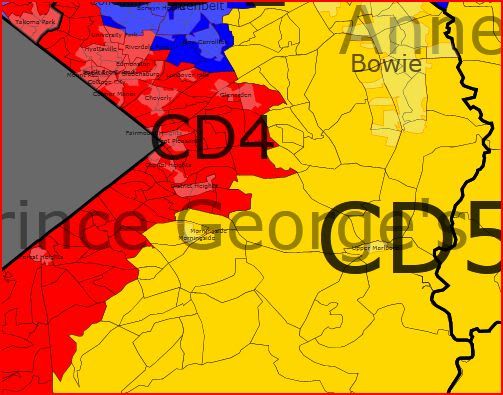Also posted at http://frogandturtle.blogspot….
(Beware, this post is long so read if you have time.)
First, this is finally finished! You may have seen me mention this map in some comments and I kept saying it was a couple of weeks away a few months ago. It took me a couple of months to map and write, including when half of the write up mysteriously vanished.
This is not the most realistic plan in the world but I wanted to see how big a Democratic gerrymander I could create. I tried to keep only seven Republicans safe while making the other seats winnable for the Democrats. Although 2010 is definitely looking like a bad year for the Democrats, 2012 with Obama on the ticket should be better. 2010 should be better than expected but that’s another story. I drew this map assuming California has 53 congressional districts after the census. Yes, I know that keeping only seven Republicans safe could turn into a dummymander because I weakened too many Democrats. I hope to avoid that and I made current Democrats safe. Many of the shakier seats should trend Democratic overtime so the Democrats will be able to pick up all the seats I made for them sometime in the decade if not 2012. I created 33 Safe Democratic, 9 Likely Democratic, 3 Lean Democratic, 2 Toss Up, 1 Likely Republican and 6 Safe Republican seats. Besides the Republican district, Obama does not win less than 53% of the vote in any district that is not safe or likely Republican. He wins 53% in only one district and 54% in two. Also, I gave the Hispanics four new districts while increasing the Asian population in the 32nd (renumbered 31st) district and 15th district. I also protected two of LA’s three African American representatives. Diane Watson is retiring so I made her district more Hispanic so the 35th (renumbered 34th) and 37th (renumbered 36th) districts will be more African American but the Hispanics will get an extra district. Also, I do not have demographic numbers for 2010 unfortunately. Here are the maps:
First, here’s a map of California’s current congressional districts. http://www.govtrack.us/congres…
Here, you can scroll down and click on California’s Congressional district names for information on them. http://en.wikipedia.org/wiki/C…

Northern California
1st District Mike Thompson (D) St. Helena (Blue)
Obama 203,307 62% McCain 117,072 36%
Change: McCain +8
Demographics: 13% Hispanic, 78% White
Communities of Interest: Redding, Santa Rosa, Eureka
Status: Safe Democratic
I removed most of Napa County except for Thompson’s home in St. Helena. I also added most of heavily Republican Shasta County. The North Coast keeps the district safely Democratic though.
2nd District Wally Herger (R) Chico (Green)
Obama 160,489 55%, McCain 122,712 43%
Change: Obama +24
Demographics: 16% Hispanic, 5% Asian, 72% White
Communities of Interest: Redding, Chico, Davis
Status: Lean Democratic
Herger’s seat makes a big turn to the left because I removed Shasta County and Republican parts of Butte County. I added parts of Democratic Sonoma and Yolo Counties. Herger is unfamiliar with these areas so he should have trouble making inroads in them. Although he still has his home in the district, I should say he will lose by seven points to a strong challenger. Also, Herger has been criticized in the past for not being an effective congressman. A race in a district like this will shake him up.

Sacramento area
3rd district Dan Lungren (R) Folsom
Obama 148,675 56% McCain 110,520 42%
Change: Obama +14
Demographics: 7% African American, 14% Hispanic, 7% Asian and 67% White
Communities of Interest: Sacramento, Folsom, Citrus Heights
Status: Likely Democratic
Lungren is already shaky in his current 49%-49% seat so a 56% Obama seat would be too Democratic for him. I added parts of Sacramento where he is not entrenched while removing Republican areas outside of Sacramento County. A strong challenger in 2012 when Obama is on the ballot should be able to knock off Lungren.
4th District Tom McClintock (R) Granite Bay (Red)
Obama 149,211 41% McCain 203,357 57%
Change: McCain +6
Demographics: 8% Hispanic, 85% White
Communities of Interest: Roseville, Lincoln, Rocklin
Status: Safe Republican
The only real change is that McClintock loses the Democratic Lake Tahoe area. He gets even safer with the addition of more Republican areas.
5th District Doris Matsui (D) Sacramento
Obama 165,279 62% McCain 96,765 36%
Change: McCain +16
Demographics: 12% African American, 17% Hispanic, 16% Asian, 50% White
Communities of Interest: Sacramento, Elk Grove,
Status: Safe Democratic
Although her district picks up some moderate Sacramento suburbs, her district still remains strong for her with a base in Sacramento.

Greater San Francisco area
6th District Lynn Woolsey (D) Petaluma (Teal)
Obama 223,326 68% McCain 99,268 30%
Change: McCain +16
Demographics: 18% Hispanic, 5% Asian, 71% White
Communities of Interest: San Rafael, Petaluma, Napa, Yuba City
Status: Safe Democratic
First, this is my home district! I am not too pleased with this district because Central Valley Democrats will have an influence over voters next to San Francisco. The district is still anchored in the North Bay so when Woolsey retires, a North Bay Democrat will replace her. A good candidate is Jared Huffman, a liberal State Assembly member from Marin County which cast 48% of the district’s Obama votes with 1/3 of the district’s population. Marin County does not have a representative in the State Senate or the House so when Woolsey retires, Marin probably will have one in the House (finally.)
7th District George Miller (D) Martinez
Obama 182,391 68%, McCain 83,750 31%
Change: McCain +8
Demographics: 14% African American, 20% Hispanic, 14% Asian, 46% White
Communities of Interest: Vallejo, Fairfield, Pittsburg
Status: Safe Democratic
George Miller loses most of Richmond and gains all of Solano County which drops the Obama percentage a bit but Miller is still safe.

San Francisco/Oakland
8th District Nancy Pelosi (D) San Francisco
Obama 282,287 85%, McCain 41,850 12%
Change: McCain +0
Demographics: 8% African American, 15% Hispanic, 29% Asian, 44% White
Communities of Interest: San Francisco
Status: Safe Democratic
Keeping all of San Francisco except part of the Sunset District, the district does not change a bit.
9th District Barbara Lee (D) Oakland
Obama 249,791 84%, McCain 41,860 14%
Change: McCain +8
Demographics: 27% African American, 19% Hispanic, 14% Asian and 36% White
Communities of Interest: Oakland, Berkeley, Lafayette
Status: Safe Democratic
Lee’s district gets a bit more Republican by going into the less Democratic cities in the San Ramon Valley such as Danville and Orinda but still stays extremely safe.
10th District John Garamendi (D)
Obama 208,364 65% McCain 108,189 33%
Change: McCain +0
Demographics: 15% Hispanic, 9% Asian, 67% White
Communities of Interest: El Cerrito, Concord, Antioch, Lodi
Status: Safe Democratic
This district keeps its anchor in north-central Contra Costa County but gains mostly white but heavily Democratic neighborhoods in Oakland and goes further into the Central Valley to pick up Republican parts of San Joaquin County. Also for Garamendi, the district picks up a few more precincts in Sacramento County.
11th District Jerry McNerney (D) Pleasanton
Obama 164,551 58% McCain 115,845 40%
Change: Obama +8
Demographics: 5% African American, 19% Hispanic, 11% Asian, 61% White
Communities of Interest: Pleasanton, Oakley, Tracy
Status: Likely Democratic
McNerney gets safer. I was able to give him Democratic Castro Valley and Oakley while removing the Republican area around Lodi. I slipped in Livermore too because Tauscher does not represent the 10th anymore and she wanted Livermore in her district. McNerney also picks up a few precincts in Stockton from the 18th district. Most of McNerney’s old territory is in the district too.
12th District Jackie Speier (D) Hillsborough
Obama 216,684 74% McCain 70,455 24%
Change: McCain +0
Demographics: Hispanic 20%, Asian 27%, 46% White
Communities of Interest: South San Francisco (the industrial city,) Redwood City, Half Moon Bay
Status: Safe Democratic
The district picks up the San Mateo County coastline and part of Redwood City but besides that, the district remains the same.
13th District Pete Stark (D) Fremont
Obama 183,890 74%, McCain 58,035 24%
Change: McCain +0
Demographics: 7% African American, 25% Hispanic, 23% Asian, 40% White
Communities of Interest: Hayward, Fremont, Santa Clara
Status: Safe Democratic
Stark’s district loses some of Fremont to the plurality Asian 15th and gains minority majority areas in Sunnyvalle and Santa Clara. These changes should not affect the district much.

South Bay (ignore the unassigned precincts, if I assigned one, all of them would be assigned. No one lives in them either.)
14th District Anna Eshoo (D) Atherton
Obama 220,962 70% McCain 90,352 28%
Change: McCain +6
Demographics: 13% Hispanic, 17% Asian, 64% White
Communities of Interest: Mountain View, Los Altos, San Jose
Status: Safe Democratic
The district loses all of Santa Cruz County and goes into mostly white areas formerly in the 15th district. Although the changes rise the McCain percentage a bit, Eshoo is still very safe and has her home in the district.
15th District Mike Honda (D) San Jose
Obama: 170,000 70% McCain 69,345 28%
Change: Obama +4
Demographics: 18% Hispanic, 43% Asian, 31% White
Communities of Interest: Fremont, San Jose, Cupertino
Status: Safe Democratic
This is one of the two Asian plurality districts I created on the map. I added Union City and Asian parts of Fremont while removing white neighborhoods in western San Jose. Honda should be safe here.

Central/Southern California
16th District Zoe Lofgren (D) San Jose
Obama 130,902 67% McCain 60,558 32%
Change: McCain +6
Demographics: 13% Asian, 50% Hispanic, 29% White
Communities of Interest: Fresno, Watsonville, San Jose
Status: Safe Democratic
I think Zoe is a great representative but I had to create more districts for Hispanic representatives. This district keeps Hispanic areas in San Jose and picks up Hispanic areas in San Benito, Santa Cruz and Fresno Counties. Although 50% Hispanic is barely a majority, the number should be 54% about now and Hispanics outside her district are not used to voting for her in the primary.
17th District Sam Farr (D) Carmel (purple)
Obama 216,197 65% McCain 109,291 33%
Change: McCain +14
Demographics: 17% Hispanic, 6% Asian, 71% White
Communities of Interest: San Carlos, Santa Cruz, Monterey
Status: Safe Democratic
The district gets whiter and safer for Farr. It is interesting though having a district represent Peninsula and San Luis Obisbo communities. I removed Hispanic parts of Monterey County and San Benito County while adding Republican eastern San Luis Obisbo County as well as some white San Mateo County neighborhoods. Farr is still very safe.
18th District Dennis Cardoza (D) Atwater
Obama 96,786 61% McCain 59,722 37%
Change: Obama +4
Demographics: 6% African American, 46% Hispanic, 8% Asian, 36% White
Communities of Interest: Stockton, Modesto, Merced
Status: Safe Democratic
Cardoza loses whiter parts of Merced County and picks up more Hispanic neighborhoods in Madera County, making the district a tad more Democratic and Hispanic.

Fresno area
19th District George Radanovich (R) Mariposa (light green)
Obama 115,407 41% McCain 157,413 57%
Change: McCain +10
Communities of Interest: Clovis, Madera, Merced
Status: Safe Republican
Radanovich’s district was safe already but now it is even safer with the removal of Democratic parts of Fresno and the inclusion of Republican parts of Merced. Also, Yosemite National Park which is Democratic was removed.
20th District Jim Costa (D) Fresno (tan/pink)
Obama 91,480 59% McCain 61,190 40%
Change: McCain +2
Demographics: 6% African American, 55% Hispanic, 7% Asian, 27% White
Communities of Interest: Fresno, Salinas, Shafter
Status: Safe Democratic
Although Costa’s district picks up Democratic and Hispanic areas in Monterey County, the district grows more Republican as it extends into Republican white areas around Fresno formerly in the 19th district. Costa’s district is still Hispanic and Democratic.
21st District Devin Nunes (R) Tulare
Obama 70,892 53% McCain 61,228 46%
Change: Obama +22
Demographics: 63% Hispanic, 25% White
Communities of Interest: Bakersfield, Visalia, Delano
Status: Likely Democratic
This is the new Hispanic majority district in the Central Valley. Nunes’s district now takes in Hispanic parts of Fresno County and Hispanic parts of Tulare County. The district also takes in Hispanic parts of Bakersfield. This district is probably too Hispanic for Nunes so he will probably not run here. The Democrats should find a Hispanic candidate who will help increase the Obama percentage by turning out the Hispanics and having them vote more Democratic. Even if Nunes runs, he should lose.
22nd District Kevin McCarthy (R) Bakersfield
Obama 96,063 37% McCain 161,271 61%
Change: McCain +2
Demographics: 22% Hispanic, 67% White
Communities of Interest: Bakersfield, Visalia, California City
Status: Safe Republican
McCarthy’s district changes as it loses San Luis Obisbo County and picks up Republican parts of Tulare and Ventura Counties. It even goes into Simi Valley which is close to the San Fernando Valley. Nunes might run in this district because the 21st is too Democratic for him. McCarthy should win because most of his current district is in the new 22nd district.
23rd District Lois Capps (D) Santa Barbara
Obama 187,384 61% McCain 115,227 37%
Change: McCain +10
Demographics: 31% Hispanic, 60% White
Communities of Interest: San Luis Obisbo, Santa Barbara, Ventura
Status: Safe Democratic
Capps’s district gets less Democratic. I removed heavily Hispanic Oxnard and added the Republican interior of Santa Barbara County. I also added Ventura and Ojai which lean Democratic. The only place where Capps’s district is a line along the coast is in San Luis Obisbo County. Although her district becomes similar to the competitive 1990’s lines, she is entrenched enough and the areas trended Democratic enough to protect her.

Greater Los Angeles area
24th District Elton Gallegy (R) Simi Valley
Obama 149,125 59% McCain 100,007 40%
Change: Obama +16
Demographics: 39% Hispanic, 9% Asian, 45% White
Communities of Interest: Oxnard, Moorpark, San Fernando Valley
Status: Likely Democratic
Gallegy’s district gets much more Democratic and the Hispanic population rises from 24% to 39% with the inclusion of Oxnard, Hispanic areas in the San Fernando Valley and the loss of interior Santa Barbara County. Although Gallegy is a popular incumbent, the 24th district is too Democratic. He is also not entrenched in Oxnard and the San Fernando Valley. This should get him to retire which he has been considering. This is a good district for Brad Sherman to run in because his district is combined with the more entrenched Howard Berman. The 24th also contains part of Sherman’s current district. If Sherman ran, he would definitely win here.
25th District Buck McKeon (R) Santa Clarita
Obama 135,401 55% McCain 106,766 43%
Change: Obama +10
Demographics: 9% African American, 31% Hispanic, 51% White
Communities of Interest: Lancaster, Victorville, South Lake Tahoe
Status: Toss Up/Tilt Democratic
Although Buck McKeon does not live in the district, it belongs to him because it contains most of his old territory. It will be harder for him to win because I added the Democratic Lake Tahoe area, moved Republican Santa Clarita into the 27th and added a few Hispanic neighborhoods in the San Fernando Valley. Although McKeon is popular, the district is trending Democratic, especially around Lancaster and Palmdale. If the Democrats find a great candidate, they should be able to kick off McKeon.
26th District Vacant (D)
Obama 128,868 63% McCain 71,638 36%
Change: N/A
Demographics: 5% African American, 56% Hispanic, 8% Asian, 28% White
Communities of Interest: Upland, Glendora, San Fernando
Status: Safe Democratic
This new district is also a new Hispanic majority district. It looks like David Dreier’s (R) current district but this district picks up heavily Hispanic areas instead of areas that lean Republican. It does contain Glendora which is Republican though. Still, a Democratic should have no trouble winning here and a 56% Hispanic population (and increasing) should be enough to elect a Hispanic representative.

Inner LA area (I removed the numbers to make the districts easier to see. You can see the numbers in the picture above this one.)
27th District Howard Berman (D) vs. Brad Sherman (D) Green
Obama 204,550 65% McCain 104,583 33%
Change: McCain +22
Demographics: 20% Hispanic, 8% Asian, 64% White
Communities of Interest: Santa Clarita, San Fernando Valley, Burbank
Status: Safe Democratic
Berman’s district gets less Democratic with the inclusion of Santa Clarita and more white but remains heavily Democratic. Sherman has less territory here than Berman so if I were Sherman, I would run in the 24th District which has part of Sherman’s current territory.
28th District Adam Schiff (D) Burbank (originally the 29th)
Obama 179,592 68% McCain 80,069 30%
Change: McCain +0
Demographics: 6% African American, 32% Hispanic, 13% Asian, 43% White
Communities of Interest: Pasadena, Glendale, La Canada Flitridge
Status: Safe Democratic
Schiff’s district remains pretty similar with a high enough white population to keep him in office and Democratic.
29th District Henry Waxman (D) Los Angeles (originally the 30th)
Obama 245,543 68% McCain 111,756 30%
Change: McCain +4
Demographics: 10% Hispanic, 9% Asian, 76% White
Communities of Interest: Thousand Oaks, Beverly Hills, Santa Monica
Status: Safe Democratic
Waxman’s district picks up marginal Thousand Oaks and loses a few Democratic areas in the San Fernando Valley. These minor changes do not affect the district’s strong Democratic lean.
30th District Xavier Beccara (D) Eagle Rock (originally the 31st)
Obama 141,239 81% McCain 29,245 17%
Change: Obama +2
Demographics: 5% African American, 61% Hispanic, 15% Asian, 16% White
Communities of Interest: Monterey Park, Los Angeles
Status: Safe Democratic
Beccara’s district was formerly 70% Hispanic but now has less Hispanics with the inclusion of white areas formerly in Watson’s district. Beccara’s district is still heavily Hispanic and safely Democratic though.
31st District Judy Chu (D) Monterey Park (tan) (originally the 32nd)
Obama 132,559 62% McCain 78,365 36%
Change: McCain +12
Demographics: 39% Hispanic, 38% Asian, 18% White
Communities of Interest: El Monte, Temple City, Walnut
Status: Safe Democratic
I know that Asians do not vote as one bloc but I think if given the choice, they will support an Asian candidate over a Hispanic one. Chu’s district gets more Asian with a small line to Walnut and Diamond Bar and the exclusion of Baldwin Park and the vicinity. I wanted to protect communities of interest but the district had to follow the VRA. Her district gets more Republican but she is still safe.
32nd District Diane Watson (D) Los Angeles (originally the 33rd) Orange color
Obama 149,611 83% McCain 28,305 16%
Change: McCain +8
Demographics: 20% African American, 53% Hispanic, 11% Asian, 12% White
Communities of Interest: Los Angeles, Culver City, Huntington Park
Status: Safe Democratic
Watson is retiring and the Hispanic population is getting too high in Los Angeles to keep three districts with African American representatives. I removed white areas in the northern part of the district and added Hispanic areas on the east and west sides of the original 35th district while taking out some African American areas in the district’s center. The Hispanic population will keep growing so the district should elect a Hispanic.
33rd District Lucille Roybal Allard (D) Los Angeles (formerly the 34th)
Obama 123,083 66% McCain 59,211 32%
Change: McCain +18
Demographics: 74% Hispanic, 18% White
Communities of Interest: Huntington Park, Downey, La Habra
Status: Safe Democratic
Allard’s district gets more Republican with losing some Hispanic areas in Los Angeles and adding whiter Whitter and La Habra. Although La Habra is Republican, Allard’s district is still safe and Democratic.
34th District Maxine Waters (D)
Obama 202,877 88% McCain 23,877 10%
Change: Obama +10
Demographics: 43% African American, 41% Hispanic, 7% Asian, 6% White
Communities of Interest: Los Angeles, Inglewood, Gardena
Status: Safe Democratic
Waters’s district gets safer as the African American population increases from 34% to 43%. Also, something interesting is you can see how high African American turnout really was by looking at the precincts. There were 930 votes in a 92% African American precinct with 1,380 people.
35th District Jane Harman (D) Venice (formerly the 36th) Purple
Obama 192,875 62% McCain 113,650 36%
Change: McCain +4
Demographics: 26% Hispanic, 15% Asian, 51% White
Communities of Interest: Torrance, Redondo Beach, Manhattan Beach
Status: Safe Democratic
Harman’s district gets more Republican with the addition of Rancho Palos Verdes which leans Republican. Communities in the district’s northern part like Venice keep Harman safe though.

Orange County area
36th District Laura Richardson (D) Long Beach (formerly the 37th)
Obama 162,948 71% McCain 61,850 28%
Change: McCain +18
Demographics: 22% African American, 40% Hispanic, 11% Asian, 23% White
Communities of Interest: Carson, Compton, Seal Beach
Status: Safe Democratic
Adding Orange County communities that lean Republican such as Seal Beach and Los Alamitos make this district more Republican. They also reduce the Hispanic population by a few points though. Richardson should have no problems from Republicans in a district where McCain won 28% of the vote though.
37th District Grace Napolitiano (D) Norwalk (formerly the 38th district)(blue)
Obama 131,462 67% McCain 59,629 31%
Change: McCain +8
Demographics: 66% Hispanic, 15% Asian, 14% White
Communities of Interest: Baldwin Park, Chino Hills, Pico Rivera
Status: Safe Democratic
Grace Napolitiano (D) has her home in the 38th district but she should run here because this district has most of her current district. The district becomes a bit gerrymandered by having the 32nd cut into the middle of it. Also, her district gets Republican Chino Hills. It is still safely Democratic though.
38th District Linda Sanchez (D) Lakewood (formerly the 39th)
Obama 135,584 60% McCain 87,210 38%
Change: McCain +12
Demographics: 6% African American, 54% Hispanic, 9% Asian, 29% White
Communities of Interest: Lynwood, Bellflower, Fullerton
Status: Safe Democratic
Napolitiano should run in the 37th district so Sanchez should be safe from a primary challenge. Also, the district should be Hispanic and Democratic enough to protect her from Republicans. Her district does get weaker with the addition of Republican parts of Fullerton though.
39th District Ed Royce (R) Fullerton (formerly the 40th district)
Obama 113,574 54% McCain 93,975 44%
Change: Obama +14
Demographics: 40% Hispanic, 18% Asian, 35% White
Communities of Interest: Norwalk, Cypress, Anaheim
Status: Toss Up/Tilt Democratic
Royce’s district gets much more Democratic with the addition of Democratic parts of Anaheim, Norwalk and he loses Republican parts of Fullerton to the 42nd. Royce is pretty entrenched in his district but not in the Norwalk area so Democrats have a strong shot at replacing him. I wish I could have done more to protect communities of interest in this district though. Also, it would not be easy for a Republican to win in a 35% White district (and decreasing.)

Inland Empire
40th District David Dreier (R) San Dimas (formerly the 26th)
Obama 127,168 58% McCain 89,498 40%
Change: Obama +14
Demographics: 7% African American, 46% Hispanic, 7% Asian, 37% White
Communities of Interest: Pomona, Upland, Rancho Cucamonga
Status: Likely Democratic
Dreier is a pretty popular incumbent but even he will have trouble in a 58% Obama district with unfamiliar territory such as Azusa, Ontario and Pomona. He also loses the most Republican parts of his current district. Dreier will probably not run and a Democrat will win easily. If Dreier runs, he will probably not be strong enough to compete with the new Democratic areas. I hope a Hispanic politician wins this seat and although Hispanics do not make a large share of voters, there should be more in the Democratic primary.
41st District Jerry Lewis (R) Redlands
Obama 104,391 41% McCain 147,051 57%
Change: McCain +6
Demographics: 20% Hispanic, 69% White
Communities of Interest: Hesperia, Beaumont, Yucaipa
Status: Safe Republican
Lewis was extremely safe before and he gets even safer. Enough said.
42nd District Gary Miller (R) Diamond Bar
Obama 131,169 40% McCain 189,640 58%
Change: McCain +10
Demographics: 15% Hispanic, 8% Asian, 71% White
Communities of Interest: Yorba Linda, Murrieta, Rancho Santa Margarita
Status: Safe Republican
Miller loses his home but he does not have to live in this district to run. His district gets more Republican by picking up the Lake Forest area formerly in the 44th and Murrieta formerly in the 45th. He has no worries.
43rd District Joe Baca (D) Rialto
Obama 107,522 66% McCain 52,753 32%
Change: McCain +4
Demographics: 14% African American, 51% Hispanic, 5% Asian, 27% White
Communities of Interest: San Bernadino, Fontana, Ontario
Status: Safe Democratic
Baca’s district gets less Hispanic but the Hispanic population is growing quickly and he is entrenched enough to survive. He should have no problems from Republicans though.
44th District Ken Calvert (R) Corona
Obama 92,733 56% McCain 70,846 43%
Change: Obama +12
Demographics: 7% African American, 43% Hispanic, 5% Asian, 41% White
Communities of Interest: Riverside, Norco, Colton
Status: Likely Democratic
In 2008, Calvert barely won reelection but he lost Riverside County. Now with the Republican parts of Orange County removed, Calvert is in trouble. I also removed Republican areas in Riverside County too and the addition of heavily Hispanic Colton does not help Calvert either. Since Calvert was already weak, it should not be too difficult to find a challenger, get the DCCC interested and kick out Calvert.
45th District Mary Bono (R) Palm Springs
Obama 113,612 57% McCain 82,064 42%
Change: Obama +10
Demographics: 10% African American, 36% Hispanic, 46% White
Communities of Interest: Moreno Valley, Perris, San Jacinto
Status: Lean Democratic
Bono is a popular moderate incumbent but she will probably lose here. I added Democratic Perris and Lake Elsinore while removing Hemet. Also, the district has fast growing African American and Hispanic populations so if a Democrat is not reelected in 2012, a Democrat certainly will be soon.
46th District Dana Rohrabacher (R) Huntington Beach
Obama 163,591 55% McCain 127,405 43%
Change: Obama +10
Demographics: 23% Hispanic, 13% Asian, 58% White
Communities of Interest: Long Beach, Irvine, Costa Mesa
Status: Lean Democratic
Rohrabacher keeps most of his old district where he is entrenched. Still, the addition of Irvine and Democratic Long Beach areas should be enough to unseat him with a good candidate.
47th District Loretta Sanchez (D) Garden Grove
Obama 89,040 55% McCain 69,075 43%
Change: McCain +10
Demographics: 55% Hispanic, 19% Asian, 21% White
Communities of Interest: Santa Ana, Anaheim, Tustin
Status: Likely Democratic
Sanchez’s district gets less Democratic and Hispanic but Sanchez is entrenched and should win Hispanic by large margins.
48th District John Campbell (R) Irvine Peach
Obama 135,283 48% McCain 144,225 51%
Change: McCain +3
Demographics: 21% Hispanic, 7% Asian, 65% White
Communities of Interest: Vista, Oceanside, Lake Forest
Status: Likely Republican
Yes, I know Campbell is a birther but I realized that if I tried to get rid of him, I would make other seats safer for Republicans that I wanted Democratic. Campbell’s district is mostly shifted out of the Irvine area into more conservative Vista and Oceanside. By the end of the decade, Campbell should be vulnerable but for now, he is unfortunately safe.
49th District Darrell Issa (R) Vista
Obama 113,663 39% McCain 175,745 59%
Change: McCain +12
Demographics: 18% Hispanic, 73% White
Communities of Interest: Hemet, Temecula, Poway
Status: Safe Republican
Issa’s home is not in the district but he should not mind. His district gets more Republican with the loss of Perris and Lake Elsinore.

San Diego
50th District Brian Bilbray (R) Carlsbad
Obama 187,575 56% McCain 144,396 42%
Change: Obama +10
Demographics: 19% Hispanic, 6% Asian, 70% White
Communities of Interest: Carlsbad, Escondido, San Diego
Status: Likely Democratic
Bilbray has faced close races in his currently marginal district but the addition of liberal parts of San Diego near the coast make the district more Democratic. He also loses more conservative areas in the east to the 53rd district. These changes should be enough to elect a Democrat.
51st District Bob Filner (D) San Diego
Obama 112,770 63% McCain 64,790 36%
Change: McCain +0
Demographics: 7% African American, 62% Hispanic, 10% Asian, 19% White
Communities of Interest: Indio, El Centro, Chula Vista
Status: Safe Democratic
I think Bob Filner is fine but I wanted another Hispanic congressman so I increased the Hispanic population from 53% to 62%. Although Filner has not faced many challenges recently, the change in population should attract a strong Hispanic candidate.
52nd District Duncan Hunter Jr. (R) Lakeside
Obama 135,237 56% McCain 101,445 42%
Change: Obama +22
Demographics: 7% African American, 29% Hispanic, 9% Asian, 51% White
Communities of Interest: La Mesa, El Cajon, Chula Vista
Status: Likely Democratic
This district undergoes one of the largest partisan changes under my plan. Duncan Hunter Jr. is new to this district. The addition of Chula Vista and Democratic parts of San Diego unfamiliar with him (and his father) will not help him. The changes should make the district Democratic enough to elect a Democrat.
53rd District Susan Davis (D) San Diego
Obama 167,156 60% McCain 107,595 38%
Change: McCain +16
Demographics: 7% African American, 24% Hispanic, 14% Asian, 51% White
Communities of Interest: Cornado, Imperial Beach, San Diego
Status: Safe Democratic
Davis’s district goes inland and therefore gets more Republican but coastal areas keep this district Democratic.
Still want more election analysis? If yes, please check out my blog http://frogandturtle.blogspot…. Thanks! I have some posts there I have not posted here yet.

Loading ...
